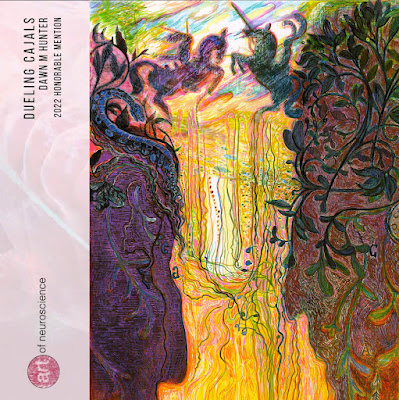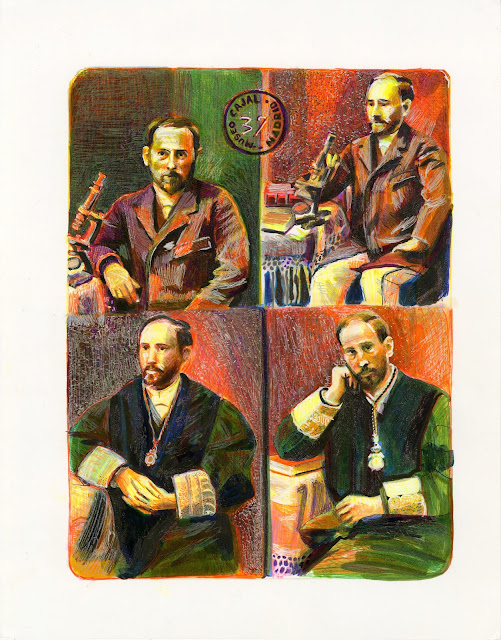Above my artwork, Dueling Cajals, receives Honorable Mention in the 2022 Art of Neuroscience
International competition.
My artwork is based on my thorough study of Cajal's life and his scientific drawings, which I conduct in collaboration with leading experts in the neuroscience field at the
National Institutes of Health,
Bethesda, MD, and Instituto Cajal,
Madrid, Spain. I have created over 300 works about Cajal in my ongoing project. My creative project aims to help increase public awareness of the wonders and how the process of drawing can create unique insight and interpretations for scientific research. Overall, my series about Cajal is biographically informative about him and his drawing process.
Me with my primary source references for my work Dueling Cajals: Cajal's Nobel Prize, his original scientific drawing of regenerative nerve cells and his death mask. All of these items are housed at the Instituto Cajal, Madrid, Spain.
Historical Background about Cajal
Santiago Ramón y Cajal (1852-1934) was born in a small town in Spain. His father was a doctor, and Cajal grew up interested in science. He went to medical school, but he also studied biology and physics. He studied the brain using histological staining methods, microscopes, micrographs, and drawing. He discovered how different parts of the brain work. Cajal was also a great teacher and helped train many scientists who would go on to make significant contributions to neuroscience, like Fernando De Castro (arterial chemoreceptors), Rafael Lorente de Nó (audio-vestibular nuclei and system), and E. Horne Craigie (zoologist and author).
Along with Camillo Golgi, Cajal won the Nobel Prize for his work in 1906.
He did his seminal work in the late 1800s and early 1900s. He is known for problem-solving and innovation, like altering and improving the Golgi Black Reaction stain, which allowed him to visualize the nervous system in unprecedented detail. His discoveries continue to be the basis for our understanding of the brain.
One of Cajal's most important contributions was his development of the
Neuron Doctrine. This theory states that the nervous system comprises individual cells called neurons. Santiago Ramón y Cajal's work on the neuron doctrine helped establish neuroscience as its scientific discipline.
Cajal, was an absolute genius, he has left a profound impact on neuroscience. He was the trailblazer for the neuron doctrine; his work was like this beacon, guiding our understanding of the brain's mysterious labyrinth. Cajal is just this pivotal force in neuroscience history. Even now, scientists and artists can't help but study and admire the incredible things he's discovered and are mesmerized by the beauty of his drawings.
It's wild to think about how much Cajal's work has shaped the field of neuroscience! His brilliant investigation into the nervous system's anatomy? A total game-changer. It's like he took a paintbrush and reimagined the canvas of our understanding. Because of him, neuroscience became its unique masterpiece, and he paved the way for many discoveries we're still making today. Even modern neuroscientists continue to reference his work, ensuring his legacy lives on for generations.
Cajal's discoveries about the brain's structure and function are like these vibrant colors, leaving a lasting impression on the field. And we're still diving into his work today, using it to make headway in figuring out neurological disorders. It's honestly so inspiring. Cajal's work is like this beautiful testament to the power of science, and it shows how vital curiosity and creativity are when we're chasing after our research.
Conclusion
I have enjoyed making artwork about Cajal's life and histology research. I am honored to have my work receive an Honorable Mention Award in the Art of Neuroscience competition and delighted that it was featured in Scientific American. To learn more about my project about him, visit my website devoted to my Cajal project, Dawn Hunter Art,™ | Cajal Portfolio.
My drawing, Four Cajals, marker and pen on paper, is based on a black and white self-portrait photo montage created and printed by Cajal. I added the color based on a color harmony system to my drawing.
Video
Below is a video that documents my process Creative Process Video for the Artwork Dueling Cajals:



